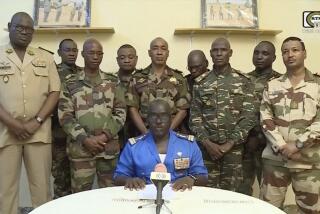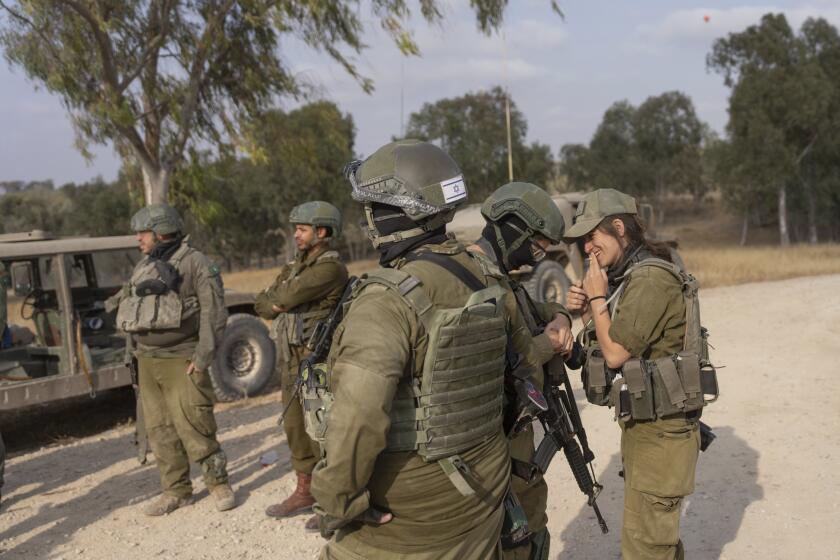U.S. Deployment Into Bosnia Picks Up Steam
Deployment of the NATO-led force of peacekeepers gathered speed Monday as the first U.S. combat troops landed in Tuzla, Bosnia, and the force commander, U.S. Adm. Leighton W. Smith, arrived at his headquarters here to take charge of the operation.
Meanwhile, the first trainloads of U.S. soldiers and equipment traveling from bases in Germany reportedly crossed into Croatia on their way south to the Sava River, where they will lay a pontoon bridge to open the way for the bulk of the 20,000 American soldiers, who will pour into Bosnia-Herzegovina in coming weeks.
A military spokesman for the North Atlantic Treaty Organization here said eight trains were expected at the site near Zupanja, about 140 miles southeast of here, before Wednesday to help build the bridge.
The arrival of U.S. forces in larger numbers came amid hopeful signs that all three warring parties to the Bosnian conflict--including the Bosnian Serbs--were preparing to abide by at least some of the initial terms of the peace settlement reached last month in Dayton, Ohio.
In Sarajevo, the Bosnian capital, U.N. officials said they had detected limited withdrawal by some of the warring armies as required by the peace agreement.
Bosnian Serb soldiers who several days ago began moving equipment, generators and supplies from Serb-held towns around Sarajevo are now also withdrawing weapons, U.N. spokesman Lt. Col. Chris Vernon said.
The arms included small-caliber mortars and some artillery pieces, Vernon said.
The Dayton agreement calls for all warring factions to withdraw at least 1.2 miles behind present cease-fire lines, and sets a deadline of 30 days after the NATO-led force takes control in the region for this to take place.
Vernon said Bosnian Croat forces also began withdrawing from around Mrkonjic Grad and Sipovo, central Bosnian towns that they captured in October but that will revert to Serbian control under the peace plan. The Croats have used weeks following the Dayton agreement to torch and loot the two towns.
Most of the Bosnian Serb air defense system also reportedly was closed down.
“The information I have is that the radars have been shut down with the exception of one . . . near the Mostar area,” Smith told reporters shortly after his arrival. “We’re having a meeting [on that issue] right now.”
At the U.S. stronghold in Tuzla, there were additional signs of cooperation.
Brig. Gen. Stanley F. Cherrie, the senior U.S. officer there, said he met with leaders of the three formerly warring factions and they all pledged to cooperate with NATO’s peacekeeping mission.
“They were more than agreeable to do what we want to assist us in getting in-country,” Cherrie told reporters near the Tuzla base runway, as heavy equipment rumbled by and a C-130 landed.
Cherrie said he informed leaders of the Muslim, Croat and Serb factions about plans for deployment in the sector and won their unanimous approval for U.S. reconnaissance missions along the route that the 1st Armored Division is expected to take south from Hungary.
“They agreed to a schedule that will kick off on Wednesday,” Cherrie told reporters. He did not elaborate on the plan.
A NATO military spokesman in Zagreb, the Croatian capital, reported that two trains carrying tanks and other heavy vehicles had to be unloaded at the town of Dakovo, about 20 miles northwest of Zupanja, because the rail lines were considered too weak to carry them.
Other reports indicated that the slow passage of trains through Hungary into Croatia had caused backups well into Austria of additional military trains carrying U.S. forces from Germany.
European-style bureaucracy appeared to be little impressed by one of the biggest movements of military forces across the Continent since World War II. One of the first U.S. military trains was reportedly held up more than four hours Sunday by Hungarian immigration officials, who insisted on conducting a detailed document check.
In Zagreb, Smith confirmed that NATO will formally relieve the beleaguered United Nations Protection Force of its Bosnian responsibilities at a ceremony in Sarajevo on Wednesday.
If that timetable holds, it will put the operation virtually back on schedule despite frustrating, weather-caused delays in getting advanced troops, known as the enabling forces, into place.
For the first time in five days, U.S. planes began landing again at the Tuzla airfield, delivering vehicles, equipment and some soldiers essential for establishing the U.S. headquarters in Bosnia-Herzegovina. A dense fog at the air base finally lifted long enough late Monday morning for planes to begin landing. The break in the weather also allowed technicians to calibrate the airport radar so that aircraft can land in cloudy weather and at night.
By nightfall, 16 of 27 flights scheduled for Monday had landed, and officials said the planes would arrive through the night.
Times staff writer Tracy Wilkinson in Sarajevo contributed to this report.
More to Read
Start your day right
Sign up for Essential California for news, features and recommendations from the L.A. Times and beyond in your inbox six days a week.
You may occasionally receive promotional content from the Los Angeles Times.






